There have been numerous innovations in synthetic biology in recent years, and the field is rapidly evolving. What was once considered science fiction is now increasingly becoming real. Artificial intelligence, genome mapping, and stronger computing power have led researchers to quickly adopt new techniques and build on concepts to build new capabilities. SynBio will transform how we produce food, energy systems, and medicines while helping us tackle some of the largest challenges facing our society today.
|
Institutional Investment: With thousands of researchers, scientists, academic institutions, government departments, private investors, and product engineers collaborating, this market has surged forward with new and amazing innovations. High-profile institutions including Harvard, University of California, US DOE, US DHHS, Bayer, Monsanto, and large biotech firms such as Genentech are all investing in the growth of this industry. |
 |
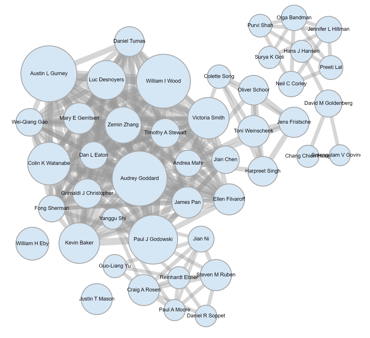 |
Individual Contributors: In Scout, we’re seeing patterns of leadership through individuals and organizations. Key industry thought leaders include Dr. Audrey Goddard with a deep background in cancer research, cell biology, and molecular biology. Other high-profile individuals such as Willam Wood of University of Colorado, Boulder and Austin Gurney Ph.D. from Case Western University are making large contributions across multiple areas. |
What's Happening Today:
Here are the top 5 categories of synthetic biology technologies that are leading to big steps forward in synthetic biology innovations we found using Wellspring Scout along with some examples of how these are being put to real-world use. These innovations will play key roles over the next decade as SynBio emerges from research labs into commercially available products. To get the most out of this article, we encourage you to create a Scout account or use the Free Flintbox account here.
1. CRISPR-Cas9:
This is a powerful genome editing tool that allows scientists to make precise changes to DNA sequences in living organisms. It has revolutionized the field of genetic engineering and has enormous potential for developing new treatments for genetic diseases.
In Scout, we are seeing a significant rise in patents (over 22k in total) over the past several years with matches to CRISPR-Cas9. 2023 is set to perform even stronger than 2022.
CRISPR-Cas9 innovation opportunities within synthetic biology in Scout (as of Q2 2023):
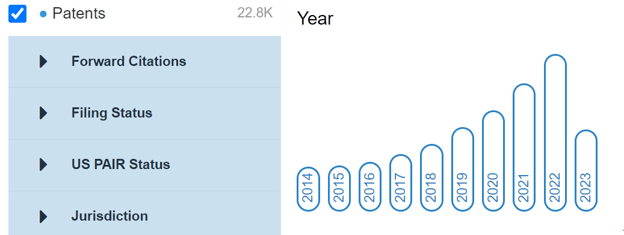
The total distribution of patents between academia and industry is split relatively evenly, with a lot of high-profile organizations across both.
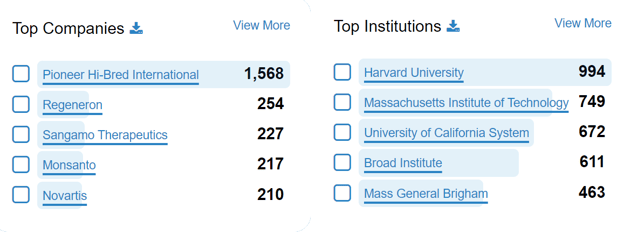
CRISPR-Cas9 Innovation Spotlights:
The following innovations are a very small selection of new CRISPR technologies we found interesting in Scout.
- Patent Application - The inventors Tim Townes, Lei Ding, and Chia-Wei Chang were issued a patent for CRISPR/Cas9 complex for introducing a functional polypeptide into cells of blood cell lineage. Learn more.
- Flintbox Opportunity - Dr. Houjian Cai, a University of Georgia researcher, has developed a CRISPR/Cas9 delivery system that leverages existing cellular transportation. This is accomplished through the incorporation of a membrane protein into the extracellular vesicle membrane and a fusion protein consisting of three parts: a sequence that causes encapsulation into extracellular vesicles, Cas9, and a nuclear localization segment. More Information
- Startup - EquiTech's mission is to serve as a pioneer in the forward development of CRISPR-Cas9 genome editing for equine diseases and is focused on rapidly moving such transformative therapies toward clinical trials. See Details Here:
The maturity trending chart (below) for CRISPR-Cas9 shows that this is still a relatively low-maturity technology with higher volumes of grants, Flintbox opportunities, and rising academic patents. There are hints of maturation with increasing industry patents and clinical trials. This technology is prime for startup formation, industrial R&D, technology licensing, and product development.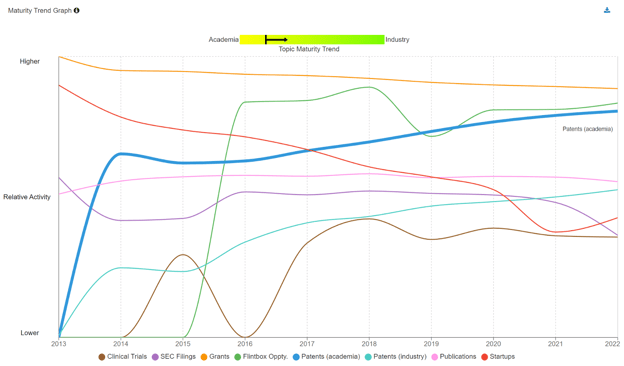
2. DNA Synthesis:
Advances in DNA synthesis technology have made it easier and cheaper to create custom DNA sequences. This has enabled researchers to design and build entirely new genes and genetic circuits from scratch.
The growth of patents surrounding DNA Synthesis isn’t quite as steep as CRISPR but makes up for it in total volume with approximately 472k patent filings indicating a strong scientific community adoption and utilization.
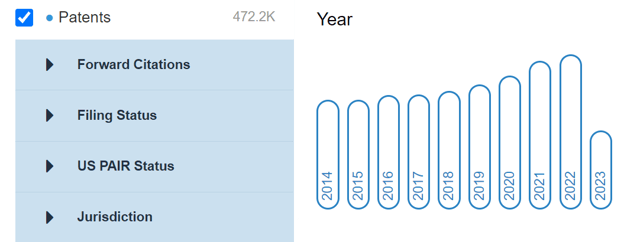
The split between academic research and industry research is relatively balanced as some of these technologies are maturing and making their way into commercialization.
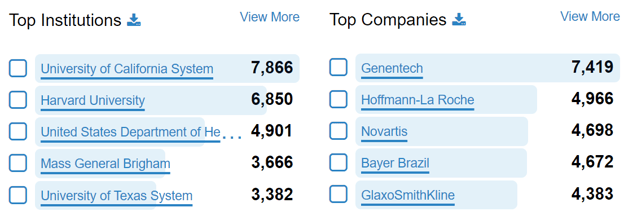
DNA Synthesis Spotlights: The following innovations are a very small selection of new DNA Synthesis technologies we found interesting in Scout across the innovation lifecycle.
- Patent Application - The inventors Linrun Feng, Jefferson Zeh Liu, and Du Jiangwen created an invention that relates to a DNA synthesis chip and a DNA synthesis method. The DNA synthesis chip is designed on the basis of the thin film transistor, so that the DNA synthesis reaction can be carried out in a specific region (pixel) as required, and the DNA synthesis chip belongs to a real programmable and high-throughput DNA synthesis chip. View Details Here
- Startup - Switchback Systems is an early-stage startup engaged in the rapid development of a highly scalable DNA synthesis platform. It focuses on dramatic minimization of time, cost, and waste, for utilization in a wide range of nucleic acid applications. The company was founded in 2019 by Mary Noe. See more details Here.
- Startup - Ansa Biotechnologies DNA is manufactured via a chemical method that has remained essentially unchanged for 35 years and has approached a plateau. Ansa Biotechnologies is developing a novel DNA synthesis technology based on enzymes that will be more fast, accurate, and clean than existing methods. The technique promises to dramatically accelerate innovation in biological research and engineering. Link to Scout Listing:
3. Directed evolution:
This is a process by which scientists can use genetic engineering to create large libraries of mutant genes and then screen them for desirable traits. This approach has been used to develop new enzymes, proteins, and other molecules with a wide range of applications.
Directed evolution patents are also seeing a progressive increase in patent activity with Scout showing around 400k total, with 2022 nearly doubling the counts available 5 years ago in 2017.
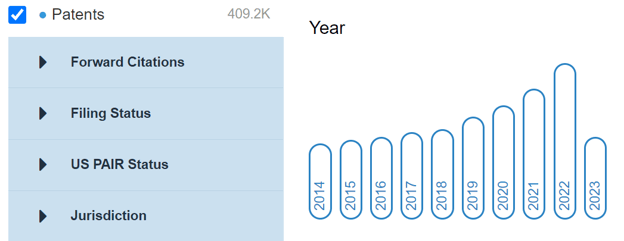
The distribution between academia and industry is starker than the previous technologies, leaning significantly more towards industry.
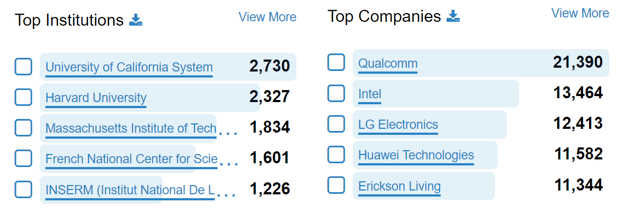
- Web Document: Explained: Directed Evolution (PDF) In nature, evolution takes place over eons: A slow accumulation of adaptations gradually produces new traits and species. But evolution can also happen on a small and fast scale in the laboratory. The approach is called “directed evolution,” and scientists are using it to generate proteins that do not occur in nature — for example, cancer drugs, new microbial enzymes for converting agricultural waste to fuel, or imaging agents for magnetic resonance imaging (MRI).
- Research Grant: $314k funding to Andrew Ellington at The University of Texas for Directed Evolution of broadly fungible biosensors. While rational design and directed evolution methods exist for altering the effector specificity of transcription factors, these methods are in general complex and slow, and have failed to solve the more general problem of identifying new protein biosensors at will. To this end, they have developed a novel directed evolution method for altering biosensor specificities, and propose to synergize these with powerful machine learning tools for improving protein function. Read more here
- Startup: Omne Possibile is a technology that will outperform current DNA and RNA technologies. They offer the transformative power of XNA in areas including healthcare, information technology, and smart materials. They provide services for XNA development: chemical synthesis, genetics, directed evolution of enzymes and genomes, automated design of molecules, and bioproduction pathways.
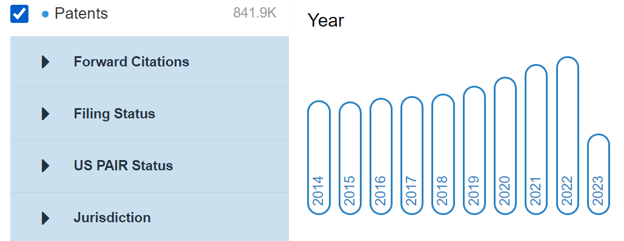
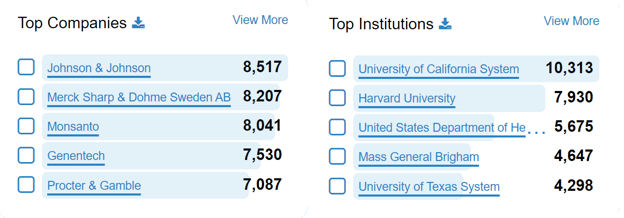
- Research Grant: Brian Belardi and Jeanne Casstevens Stachowiak at The University of Texas have received $1.5M in funding to research Synthetic Adhesome Cells: Engineering Interfaces Between Synthetic and Live Cells for Controlled Delivery. This research team will focus on the user-defined transfer of material between synthetic cells and living cells, which will ultimately lead to new delivery mechanisms to alter biological behavior for biotechnology, chemical sensing, and biomedicine. Learn more Here
- Patent: The University of Connecticut applied for a patent for Synthetic Artificial Stem Cells. This disclosure relates to an engineered novel synthetic artificial stem cell (SASC) system which mimics the paracrine effect of the stem cell secretome and provides tailorability of the composition for targeted tissue regeneration. This novel SASC system demonstrates the feasibility of developing a completely synthetic, tailorable stem cell secretome which reinforces the possibility of developing a new therapeutic strategy that provides better control over targeted tissue engineering applications. Learn more here
- Startup: Satellite Bio received $82M investment in 2022. Satellite Bio specializes in cell therapy, regenerative medicine, synthetic biology, cell biology, and tissue engineering. It focuses on the development and implementation of proprietary, off-the-shelf, implantable satellite organs as living therapeutic solutions that can transform the lives of millions of patients who suffer from serious diseases.
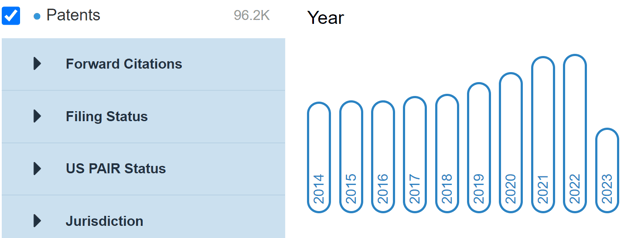
The distribution of activity in Scout leans more towards the industry side with more activity at some of the larger AgTech or Chemtech organizations such as Monsanto, Dupont, and BASF.
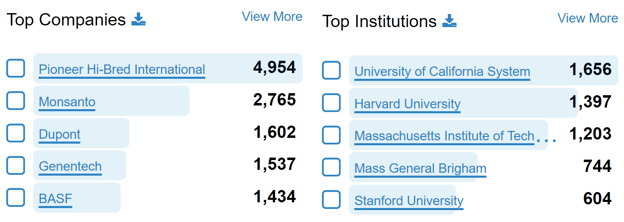
Metabolic Engineering Spotlights from Scout:
- Research Grant: The National Institute of Health funded a research project for $575k to Virginia Cornish of Columbia University. The goal is to create general, high-throughput assays that are modular and broad in scope to overcome the current bottleneck in testing the enormous diversity required for solving metabolic engineering problems. If successful, these technologies will enable powerful directed evolution approaches to be routinely applied to the biosynthesis of natural products and their analogs. Learn more
- Patent: Researchers at the National University of Singapore filed a patent application for the following. The invention provides a method for increasing the production of free lipoic acid in isolated genetically engineered bacteria or yeast cells. The method involves culturing the engineered bacterium or yeast in a culture medium supplemented with cysteine, the engineered bacterium or yeast being transformed by a recombinant expression vector encoding a polynucleotide molecule, resulting in overexpression of the following genes linked to at least one promoter. Learn More
- Startup: Cysbio received $6.2m in funding based on the commercial viability of their technologies. Cysbio uses advanced metabolic engineering and synthetic biology approaches to construct bacterial cell factories for transforming the production of biochemicals from renewable feedstocks. Learn More
Summary:
These are just a few examples of the many new innovations in synthetic biology. As the field continues to evolve, we can expect to see many more exciting developments in the coming years. While I can't see into the future, I'd be willing to bet that in 30 years, we'll look back on this time as the explosive golden age of synthetic biology that helped to transform many aspects of our lives for the better.
If you have any ideas or recommendations to improve this article, please reach out through the form below, and will be happy to connect and discuss.
